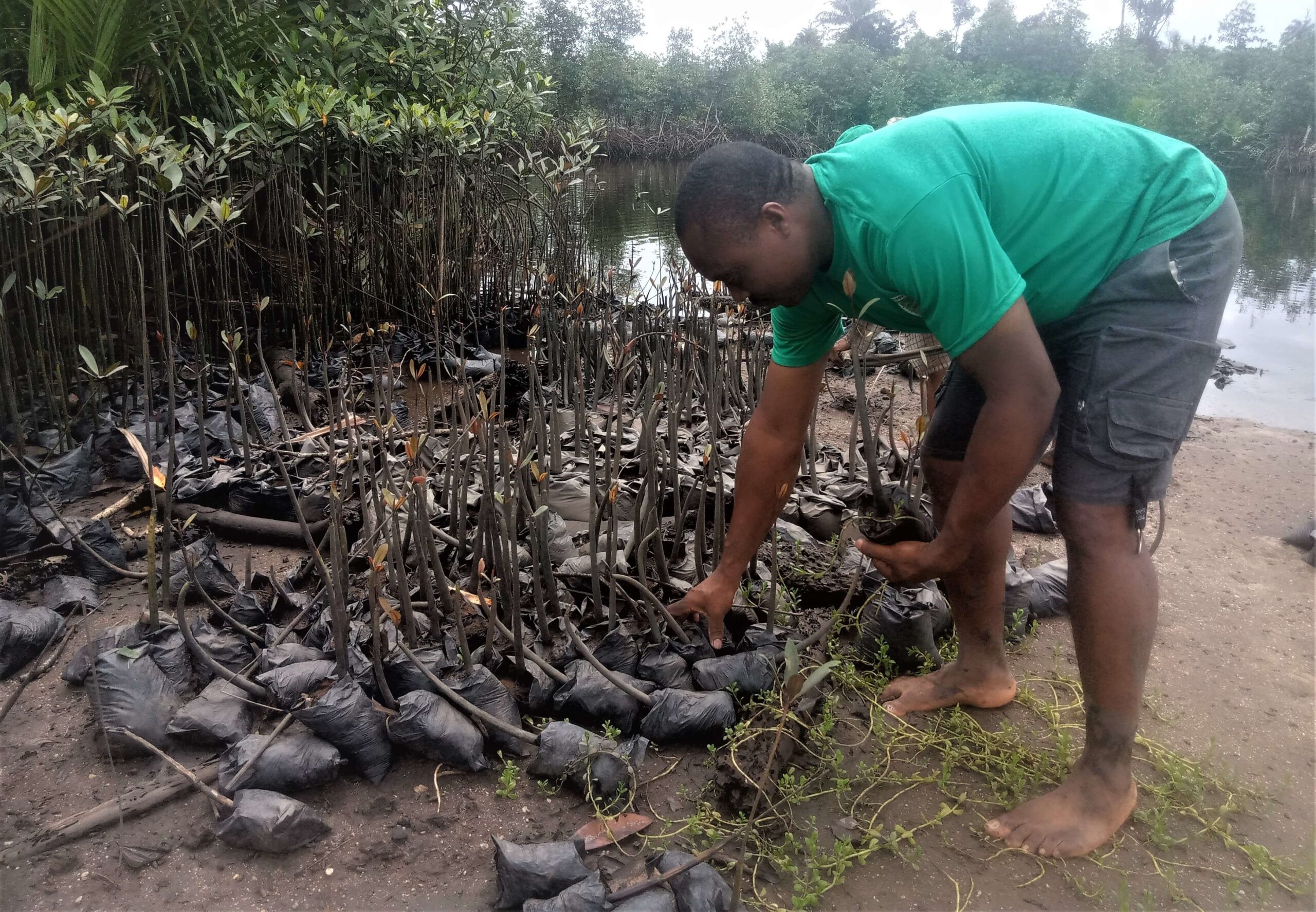URUA ESSIEN ETUK, AKWA IBOM: As the screeching tyres of his silver-coloured Honda car turn right on the untarred road leading to Urau Essien Etuk community, Ikponke Nkanta lets down his window to greet the locals coming close to welcome him.
This shoreline community – a tiny part of southern Nigeria’s oil-rich Niger Delta region – is one hour and 30 minutes drive from Uyo, capital of Akwa Ibom State, Nigeria’s highest oil-producing state.
Nkanta’s visit to the community this cold Friday morning of October 2022 is to monitor ongoing mangrove regeneration projects his organisation, the Tropical Research and Conservation Center or TRCC, introduced to several shoreline communities in the state in March 2018.
“We need a strong conservation effort to conserve our mangrove forests. Otherwise, in a few years to come, we might not have them again,” said Nkanta, director of TRCC, a nonprofit that facilitates indigenous conservation efforts in Akwa Ibom.
All-important but threatened
Mangroves are a group of tropical plants or trees, mostly surviving on coastal and salty water. Besides acting as a nursery for fish and other marine animals, mangroves play a massive role in protecting coastal communities.
They prevent erosion and act as shoreline protection against storms and floods. And as an essential nature-based solution to the climate change crisis, mangrove forests control global warming by storing carbon and other greenhouse gases.
Yet, recurring problems of oil spills in the Niger Delta and deforestation due to increasing demand for wood for domestic uses and building construction are putting increasing pressure on the mangrove ecosystem in Nigeria, which is the largest in Africa.
In West Africa, Nigeria had the greatest loss of mangroves – about 432 square kilometres – between 1975 and 2013.
Now, carbon stored by mangroves is released back into the atmosphere, aggravating the global climate crisis and affecting those whose livelihoods depend on fishing.
The problem is not unique to Nigeria. Around the world, the extent of mangroves decreased by 5,245.24 square kilometres between 1996 and 2020, according to Global Mangrove Watch, an online mangrove-monitoring platform.
Restoration through division of labour
TRCC started its regeneration project in several Akwa Ibom communities in 2018. In Urau Essien Etuk, for example, it began by meeting with community leaders, explaining the importance of its intended mangroves restoration and the dangers of mangroves loss, including the reduction of fish population and contribution to the climate crisis. It pointed to heat waves, floods, and erosion in the delta as climate-related events threatening coastal communities.
As soon as the community agreed to participate in the project, TRCC started training the locals on how to get red mangrove tree seedlings and take them to the nursery, where they are grown to a certain level before they are transferred to deforested areas for planting. The training lasted about three months, and when it ended, the locals began growing the nurseries.
The team from TRCC came thrice a week to facilitate the planting exercise based on suggestions from the locals who know best when the waves come and recede.
Working with the community chief, TRCC informed members of the community what time of the day planting would happen – morning or afternoon. The community gathered at the water edge for specific instructions before they moved to the planting sites.
The work was shared. Women picked the seedlings that fell from matured mangrove trees in the forest and put them in muddy soil in the nursery. When the seedlings grew after one to three months, young boys and men transferred them to the planting site – only accessible by boats. They gave a space of one mitre between seedlings.
There are ten planting sites in Urau Essien Etuk where about 50, 000 mangroves covering five hectares have been planted so far. And in the state, over 300 000 mangroves covering 20 hectares have been planted. Nkanta said planting continues until all deforested areas in the state are covered.
TRCC’s message has sparked an attitude change among many community youths. In the past, they cut down mangroves; now, they plant them.
“I started planting four years ago, and I have planted [about] 5, 000 mangroves in five [planting] sites,” 18-year-old Imo Iniobong said, smiling as he held the mangrove seedling. “I love it; I sometimes invite my friends from school to come and see.”
After each day’s planting, TRCC gives each local a stipend of N2000 ($4.34). Udo Dick, a 45-year-old farmer, said the stipend encourages her to continue working.
“It is just Sundays that we don’t work,” the mother of four said. “Each time I work there, I get the money, which helps me in my house.”
Fighting climate change
When TRCC launched in June 2001, it focused on promoting sustainable agricultural practices and protecting endangered species in the Niger Delta. But when Nkanta noticed that mangrove forests were disappearing, biodiversity losses were increasing, fish populations were reducing, the climate crisis was compounding, and people were losing abundant forest crops, he decided to introduce the mangrove regeneration project in 2018 to address these interconnected problems.
“People in our society have been affected by climate change, and one of the mitigation efforts is tree planting. Good enough, mangrove has a strong capacity to absorb carbon, so it is one ecosystem critical now in fighting climate change,” Nkanta explained.
Since introducing the regeneration project, funding from organisations like the United Nations Development Programme and Global Environment Facility has enabled Nkanta and his team of 10 to sustain the conservation project.
TRCC continues to hold workshops quarterly with locals, educating them on why the mangrove ecosystem is critical to biodiversity conservation.
“From the onset, we adopted a participatory approach [and] made it community-based, where the community people drive it, and we just facilitate,” Nkanta said, crossing his legs as he leaned on a mangrove tree.
But despite his effort, some impoverished locals still cut the mangroves for their livelihoods. He said they do so because they do not have good equipment like boats and nets for fishing. And, for limited resources, TRCC cannot provide fishing gear to everyone who needs them.
“If they cannot focus on fishing, it is a problem [and] if there are no resources, they might be tempted to fall back to deforestation,” he said.
Nonetheless, he is happy that many young people are coming out to own the project and hopeful that the mangroves in Akwa Ibom will be entirely restored with time.
And the insight one learns from the response is how TRCC penetrated community leaders, working with them to spark community-wide involvement in the mangroves restoration project.
This story was produced with the support of Nigeria Health Watch through the Solutions Journalism Network, a nonprofit organisation dedicated to rigorous and compelling reporting about responses to social problems.
Ikponke Nkanta, director of the Tropical Research and Conservation Center (TRCC), visits Urau Essien Etuk, a coastal community in Akwa Ibom, Nigeria, to monitor mangrove regeneration projects initiated by TRCC in March 2018. Mangroves play a crucial role in protecting coastal communities, preventing erosion, and combating climate change by storing carbon.
Despite their importance, mangroves are under threat due to oil spills and deforestation. Nigeria, possessing the largest mangrove ecosystem in Africa, has suffered significant losses. TRCC's project involves collaborating with local communities to plant and nurture mangrove seedlings, aiming to restore deforested areas.
The project, funded by organizations like the United Nations Development Programme and Global Environment Facility, trains locals in mangrove cultivation. Community involvement has increased, with many locals now actively participating in the conservation efforts.
Although some continue to cut mangroves for survival, the initiative has sparked a positive attitude change among youths. TRCC is hopeful that, with sustained efforts, the mangrove forests in Akwa Ibom will be fully restored, significantly contributing to climate change mitigation and biodiversity conservation.
This story highlights the role of community-led efforts in addressing environmental challenges, supported by the Solutions Journalism Network.






